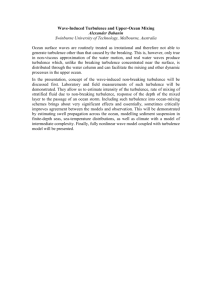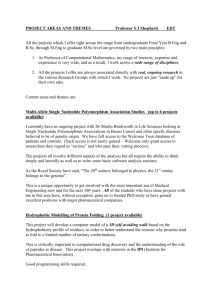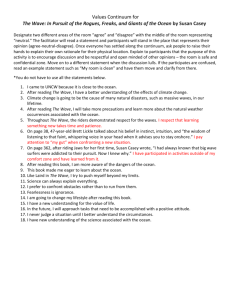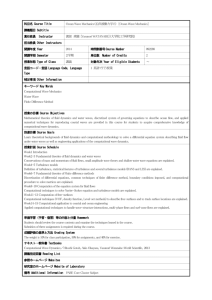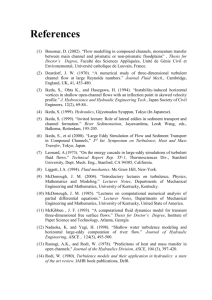13-17_Mar_WARWICK_Sy..
advertisement
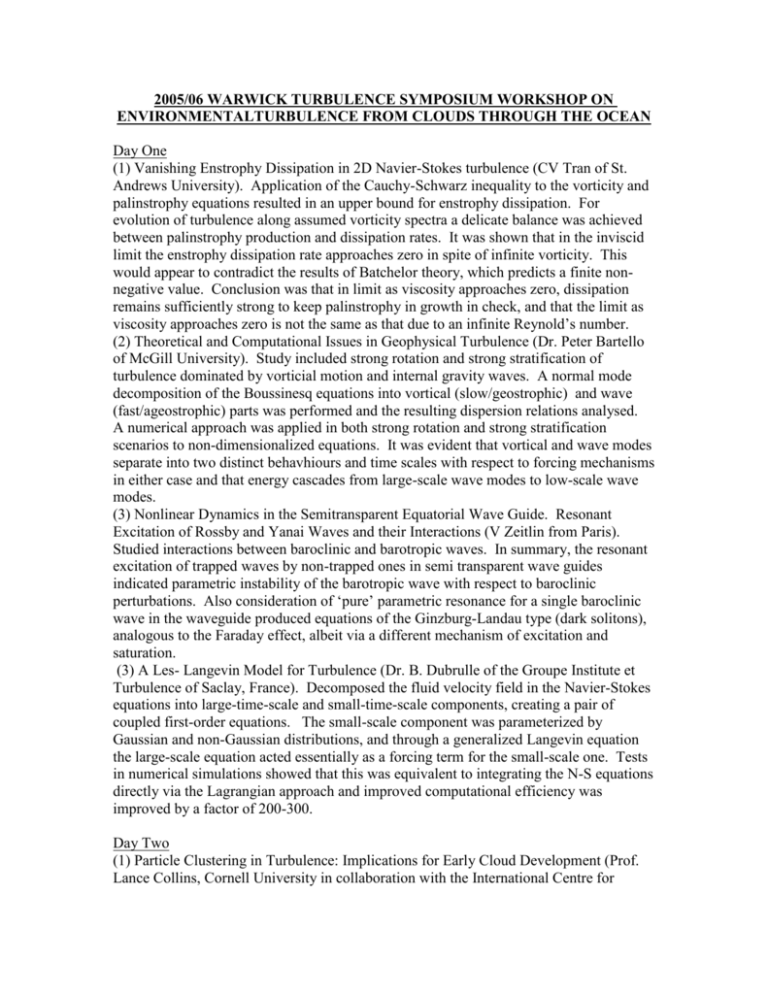
2005/06 WARWICK TURBULENCE SYMPOSIUM WORKSHOP ON ENVIRONMENTALTURBULENCE FROM CLOUDS THROUGH THE OCEAN Day One (1) Vanishing Enstrophy Dissipation in 2D Navier-Stokes turbulence (CV Tran of St. Andrews University). Application of the Cauchy-Schwarz inequality to the vorticity and palinstrophy equations resulted in an upper bound for enstrophy dissipation. For evolution of turbulence along assumed vorticity spectra a delicate balance was achieved between palinstrophy production and dissipation rates. It was shown that in the inviscid limit the enstrophy dissipation rate approaches zero in spite of infinite vorticity. This would appear to contradict the results of Batchelor theory, which predicts a finite nonnegative value. Conclusion was that in limit as viscosity approaches zero, dissipation remains sufficiently strong to keep palinstrophy in growth in check, and that the limit as viscosity approaches zero is not the same as that due to an infinite Reynold’s number. (2) Theoretical and Computational Issues in Geophysical Turbulence (Dr. Peter Bartello of McGill University). Study included strong rotation and strong stratification of turbulence dominated by vorticial motion and internal gravity waves. A normal mode decomposition of the Boussinesq equations into vortical (slow/geostrophic) and wave (fast/ageostrophic) parts was performed and the resulting dispersion relations analysed. A numerical approach was applied in both strong rotation and strong stratification scenarios to non-dimensionalized equations. It was evident that vortical and wave modes separate into two distinct behavhiours and time scales with respect to forcing mechanisms in either case and that energy cascades from large-scale wave modes to low-scale wave modes. (3) Nonlinear Dynamics in the Semitransparent Equatorial Wave Guide. Resonant Excitation of Rossby and Yanai Waves and their Interactions (V Zeitlin from Paris). Studied interactions between baroclinic and barotropic waves. In summary, the resonant excitation of trapped waves by non-trapped ones in semi transparent wave guides indicated parametric instability of the barotropic wave with respect to baroclinic perturbations. Also consideration of ‘pure’ parametric resonance for a single baroclinic wave in the waveguide produced equations of the Ginzburg-Landau type (dark solitons), analogous to the Faraday effect, albeit via a different mechanism of excitation and saturation. (3) A Les- Langevin Model for Turbulence (Dr. B. Dubrulle of the Groupe Institute et Turbulence of Saclay, France). Decomposed the fluid velocity field in the Navier-Stokes equations into large-time-scale and small-time-scale components, creating a pair of coupled first-order equations. The small-scale component was parameterized by Gaussian and non-Gaussian distributions, and through a generalized Langevin equation the large-scale equation acted essentially as a forcing term for the small-scale one. Tests in numerical simulations showed that this was equivalent to integrating the N-S equations directly via the Lagrangian approach and improved computational efficiency was improved by a factor of 200-300. Day Two (1) Particle Clustering in Turbulence: Implications for Early Cloud Development (Prof. Lance Collins, Cornell University in collaboration with the International Centre for Turbulence Research). Improved upon current microphysical models, which predict condensational growth and cloud droplet distributions far slower and narrower than observed. In summary, the role of turbulence in clouds is to enhance the collision and coalescence rate of cloud droplets; to cause macroscopic mixing of moist and dry air and microscopic clustering of inertial droplets. Clustering in clouds consequently generates fluctuations in super-saturation of water vapour and increases collision frequency by 1-2 orders of magnitude. In addition, aerosol particles in a turbulent flow field preferentially cluster outside of vortices due to a centrifugal effect, which broadens the drop size distribution thus accounting for the size gap discrepancy. Effects of various fluid parameters upon particle size distribution and evolution were also considered. Further study includes additional experiments, laboratory and field studies, probe of higher Reynolds numbers, and integration to improve climate models. (2) Turbulence and Geophysical Flows (Julian Kent, UCL). Examined the behaviour of vortices due to turbulence. (3) Turbulence and Clouds: A Measurement Perspective (Raymond Shaw, Michigan Tech) In summary, there are numerous effects due to cloud-turbulence interactions. Conclusions: (i) Solving the droplet size distribution alluded to by Dr. Collins requires we consider interactions of droplets, thermodynamics, and turbulence on multiple scales. (ii) Precipitation formation, a crucial aspect of climate, is highly sensitive to size distribution and the ‘early’ state of the cloud. (iii) Inertial clustering occurs in clouds, the relevance of which remains to be determined (iv) Role of entrainment in homogeneous and inhomogeneous mixing is significant- for example, relatively large droplets were in some cases found in diluted regions of relatively less vigorous clouds, an unexpected result. (4) Role of Cloud Turbulence in the Formation of Rain (Alexander Fouxon, Isreal). Considered particles in flow consisting of a collection of vortices (as heavy particles in a centrifuge hurled into the hyperbolic region between the vortices) Summary: Droplets collision kernel in turbulence was strongly enhanced with respect to mean field estimate due to preferential concentration and the sling effect, both enhanced by intermittency of turbulence with respect to Kolmogorov 1941 estimates. The main missing element in Direct Numerical Simulations (DNS), in need of theoretical study, is turbulent mixing of interacting fields of vapour density, droplet concentration, and vapour temperature. (5) Multi-fractal Acceleration Statistics in Turbulence (Ben Devenish, MET Office, in collaboration with University of Rome Dr. Biferale, Lanotte F. Toschi) Investigated the statistical properties of velocity and acceleration fields along fluid particle trajectories in turbulent flow for Lagrangian velocity structure functions and compared results with the multi-fractal formalism. The probability density functions derived (based solely on assumptions of Gaussianity of velocity and simple requirements on the velocity increments) were in excellent agreement with DNS. (6) Small-Scale Turbulent Mixing in Clouds: Numerical and Experimental Results (Dr. Szyman Malinowski, Warsaw University). Conclusions: (i) Mixing of cloud with clear air is a 2-phase reacting flow substantially influenced by submerged heavy particles in cloud droplets. (ii) In the appropriate conditions (mixing with sub-saturated air) droplet evaporation substantially influences the smallest scales of turbulence. (iii) For moderate and small values of initial Turbulent Kinetic Energy (TKE) this influence is substantial or even dominating. (iv) Droplet sedimentation is important as a transport mechanism of liquid water from cloudy to clear air filaments for low levels of initial TKE. (v) This mechanism depends strongly on droplet spectral distribution. (vi) Buoyancy production in cloud-clear air mixing causes even the smallest scales of turbulence to be highly anisotropic. Day Three (1) The Structure of the Marine Cloud Topped Boundary Layer (Peter K. Taylor, National Oceanography Centre Southampton). Covered JASIN (Joint Air Sea Interaction Experiment). (2) Wave Induced Turbulence in the Upper Ocean (W. Kendall Melville, Scripps Institute of Oceanography) Langmuir circulations. Wave breaking limits height of surface waves, dissipates surface wave energy and transfers momentum from waves to currents, and is a source of vorticity. It exhibits translational phenomenon, enhances heat and gas transfer through turbulence and bubbles, is a major source of sound in the ocean, and a source of active/passive microwave signatures. Breaking at larger scales may result from dispersive focusing, geometric focusing, wave-wave and wave-current interactions without wind forcing being directly involved. Work done against buoyancy in entraining air comprises about 50% of energy from the wave-field. Air entrainment and mixing: breaking waves entrain air as the surface water is rapidly mixed down to depths comparable to wave height- subsequently, slower processes mix the air-water mixture down to greater depths- the smallest bubbles are tracer for fluid originally on surface. Entrained air breaks up into bubbles which may enhance gas transfer. Individual bubbles and clouds may radiate sound as they relax to equilibrium configurations- invert for airsea fluxes single bubble; ocean optics- scattering, reflectance, attenuate; strong attenuation of light and sound waves under a moving surface (3) Wind-Wave Interactions (Stephen Belcher, University of Reading Department of Meteorology). Previous models consider linear, normal mode instability for sinusoidal waves. Main question was importance of nonlinear effects, and unsteadiness- motivated by large scale Rossby waves in the atmosphere. Suggested role of 3D turbulence in the stages of evolution and two competing mechanisms for curvature balance: critical layer mechanism removes curvature, turbulence restores curvature. Conclusion: physical picture to critical layer mechanism, critical layer is an unsteady problem, leads to pulse of momentum, mechanism robust to complex waveforcing wave groups/breaking waves (4) Temporal and Spatial Growth of Wind Waves (M.Stiassmie) (5) Theoretical and Experimental Modeling of Intense Atmospheric Vortices (Galina Levina, Institute of Continuous Media Mechanics, Perm Russia). Aim was theoretical, laboratory, and numerical modelling to study large-scale intensive vortex formation in the atmosphere and physical mechanisms involved in cyclogenesis. Turbulent vortex dynamo theory gave a threshold for large-scale vortex instability and resulted in positive feedback between horizontal and vertical circulation, causing intensification and qualitative change in heat transfer- this is a new effect. Numerical simulation model simulated the influence of small scale helical turbulence generated by joint effect of Coriolis force and internal heat release. The next steps are Direct Numerical Simulations with and without helical force for Boussinesq convection and the examination of helical effects in tropical cyclogenesis. Parameterization of helical features of convective atmospheric turbulence and a way to examine the hypothesis of turbulent vortex dynamo in simulation of tropical cyclogenesis have been proposed. Day Four (1) Modulation of Air-Sea Interaction by Geostrophic Turbulence in the Ocean (John Marshall, MIT) Summary: Water mass transformation in the ocean occurs over many interacting scales due to convection, geostrophic eddies, and general circulation. Formation rates of 18 degree water inferred from air-sea fluxes at odds with what we know about observed volume and likely dissipation rates. It was hypothesized that either air-sea flux measurements are grossly in error or missing turbulence or both- and argued that neglect of lateral eddy processes may be the key. The Clivar Mode Water Dynamics Experiment (CLIMODE), supported by NSF, was lauched to study how air-sea interaction is modulated by synoptic variability. The field experiment is still ongoing. (2) Turbulence and Mixing in Shelf Seas (John Simpson with funding by NERC, EU and DSTL). (3) Stirring Vegetable Soup (Adrian Martin from U.Southampton) Conclusions: turbulence strongly affects plankton ecology and plays a major role in controlling regional primary production at the mesoscale; lateral turbulent stirring and mixing is just as important as the vertical supply of nutrients; correlations between coherent structures and up-welling regions can exert very strong influence the carbon cycle. (4) Mid Latitude Ocean Atmospheric Model Decadal Variability and Dynamics ( ) Summary: coupled quasi-geostrophic ocean-atmospheric model has astonishingly rich nonlinear dynamics. It is a powerful tool for analysis of interactions between climate variability and mesoscale turbulence; solution of turbulent ocean-atmospheric model are analyzed and decadal coupled variability is found for wide range of physical parameters; both variability mechanisms and fundamental role of oceanic eddies understood in terms of basic fluid mechanics; eddy effects modelled (parameterized)--(5) Tuning and Validation of Ocean Mixed Layer Models (National Center for Ocean Forecasting) Forecasting Ocean Assimilation Model , Mixed layer- surface layer of ocean where temperature, salinity and density nearly uniform due to turbulent mixing. Tuning the Kraus-Turner model: KT model based on a TKE budget, sources of TKE are wind mixing and convection, 15% of potential energy released by convection converted to TKE, TKE decreases by work done in overturning stable strat and by dissipation,… (6) Variability of Surface Circulation (Greg King, Warwick University) First foray into satellite data analysis. Costal up-welling period of Western Iberia July, August, September. Objective- use of SST imagery and analysis to investigate space/time variability of upwelling from 1994-2005, look for NAO influence and mass/biochemical changes between the coast and… Satellite measurements give temperature of top millimetre of water. Objective to investigate satellite imagery, extract upwelling index (difference in SST between mid-shelf and open sea as a function of time and latitude), difficulties- missing data, cloud, data reduction method- empirical orthogonal functions (EOF analysis). Conclusion: there is indeed variability in the surface circulation Day Five (1) Representing Gravity Current Entrainment in Large-Scale Ocean Models (Robert Halberg from NOAA/GFDL and Princeton University). Summary: (i) Overflows are critical in formation of most deep-ocean water masses; (ii) Turbulent mixing with right rate is critical for models to be accurate; (iii) Large-scale models require parameterizations of such mixing that capture both the equilibrium turbulence and (sometimes) its equilibrium modification of resolved flow; (iv) Mature Kelvin Helmholtz-like mixing significant in the interfacial layers atop gravity currents; (v) Bottom-stress driven turbulence is significant for homogenizing the bottom boundary layer and must be parameterized. (2) Making Practical Progress in Parameterizing Turbulent Mixing in the Deep Ocean (Sonya Legg, Princeton) Tides and winds are likely source of energy for deep diapycnal mixing, which is necessary to close the thermohaline circulation. Climate models need physically based parameterizations of spatially and temporally varying tidal mixing, which was the focus of the talk. Most tidal energy is dissipated in coastal oceans, but the swellant dissipated in deep-ocean has a large impact upon the climate. Different climate scenarios (e.g. raising/lowering sea level) would have different dissipation patterns. 33 percent of energy from ocean tides dissipated in the deep ocean, is used for mixing stratified ocean interior, some mixing local to topography, some energy carried throughout ocean by waves, leading to distributed mixing. Mechanisms of mixing due to barotropic tides include rough topography, wave breaking, and wave-wave and wavetopography interactions. Current global climate models do not simulate this chain of events. Also, analytical studies typically assume the governing topographic/flow parameters are small, a restriction lifted in numerical simulations. Internal tide generation by finite amplitude barotropic tides was numerically simulated as a function of topographical and fluid parameters. The main result was that energy dissipation was greatly enhanced for very narrow topographies topographical dimensions, which was attributed to smaller vertical length scales in internal tides. Conclusions: energetically consistent parameterizations of tidal mixing are now becoming a possibility. These parameters must include estimates of: (i) Energy conversion from the barotropic tide; (ii) The fraction of this energy used for local mixing and the spatial distribution of this mixing; (iii) The internal wave field generated by the tides; (iv) The locations of internal wave breaking and the mixing thus generated. Many questions still remain, and the theoretical, observational, and numerical work are all needed to answer them- but we mustn’t be afraid to use what we already know, however approximate, to improve climate models. (3) Development of an Ocean-Atmospheric Model on Isocahedral Grids (Peter Korn, Max-Planck Institute for Meteorology, Hamburg). The Isocahedral Non-hydrostatic General Circulation Model (ICON) was developed in a joint project with the German Weather Service. This is the unified model for global and regional modelling which utilises a isocahedral. The ICON structure separates numerics from physics, exploits similarities between atmospheric and ocean equations and imposes conservation of discretized equivalents of global invariants. Physical variables are defined on a triangulated version of the grid (hexagons) and discretized operators decomposed on a dualized (triangular) gird. Mass fluxes out of the dual cell are specified and shallow water equations are integrated. Although enstrophy conservation is a property of the grid, the model is not energy conserving. The model was applied to discretized shallow water equations. Challenges include avoidance of interface artefacts and to overcome grid scale limitations upon the threshold of turbulence modelling. (4) Modeling Environmental Flows at a Range of Scales Using Adaptive Methods (Matt Piggott, Imperial College UK) The concept is to allocate computational resources to nodes where most needed to optimize computing costs in the simulation of nonhydrostatic dynamics, using the freedom to choose the sub-grid scale (SGS) to our advantage while maintaining due regard for how variable resolution and differential discretization modelling options interact. Given that variable resolution via mesh adaptivity and stabilized discretization methods typically introduce some kind of dissipation, there is need for an underlying numerical method that does not introduce grid scale noise and minimizes spurious dispersion or dissipation. The main aim is to develop a new modelling framework able to simultaneously resolve coupled dynamics at a range of scales while removing spurious noise in geophysical scale applications. Mesh optimization makes local topological changes to the mesh so that it appears homogeneous and isotropic in the transformed space defined by an error metric tensor. Unstructured meshes represent an excellent framework for anisotropic mesh adaptivity. Other advantages include: accurate efficient domain representation, imposition of boundary conditions, and mesh flexibility in all directions. The mesh optimization procedure, to amend differential equations via an operator and perform a Galerkin discretization, leads to a variety of stabilized numerical methods. The Galerkin Least Squares SGS method is the simplest proposed variational multiscale method, which was utilized to achieve a third-order accurate scheme with a leading order fourth-order dissipation term. The sensitivity/adjoint goal based error measures were constructed from the solution of an adjoint problem and the model residual (estimates of which should contain contributions due to both discretization and modelling). Summary: Unstructured adaptive mesh methods are able to robustly solve for environmental and geophysical flows; Numerical method needs to minimize spurious dissipation so that there is no “double-counting” when SGS modelling is employed; Error measure can have contributions from discretization errors, turbulence models, and in principle models of other SGS physics; Possibility exists to test SGS models of certain processes by simply resolving them in a calculation; A high-order implicit numerical stabilization (ILES) is currently in implementation; Main question- Does the mesh adaptivity inhibit any true physical behaviour (e.g. vertical mixing/convective plumes), and to what extent are results model independent? (5) “Non-Traditional” Coriolis Terms, Inertial Waves, and Mixing in the Deep Ocean (Victor I Shrira, Keele University) Introduction: Global warming predictions are based primarily upon climate models, which are in turn based on ocean circulation models which are based on turbulence/mixing parameters. The reliability of these predictions has not been established. Arguments exist for mixing caused by internal wave breaking, but no specific mechanisms have been identified. Nevertheless, the author suggested a plausible mechanism of wave breaking in the ocean and developed its quantitative description. In the traditional approximation, internal waves and all oceanic motions of scales much smaller than the radius of the earth are commonly described as though the earth is locally flat and consider motions in the plane tangent to the earth’s surface. The fundamental flaw in this argument lies in the implicit assumption that effects due to the horizontal component of rotation represent a regular perturbation. Utilizing the WKB approach to the boundary value problem including the non-traditional term, the author inferred a higher-order singularity in the dispersion relation and the existence of trapped sub-inertial propagating wave modes representing a smooth continuation of corresponding superinertial branches. In summary, a complete linear theory was developed to describe vertical focussing of sub-inertial finite width wave packets approaching the singularity. The singularity acts effectively as a black hole (no reflection or spreading of waves). Given the initial wave amplitude, we can predict when this wave will break, thus contributing to mixing. Unknowns include: initial amplitude; leakage of wave energy through nonlinear interactions; overall impact on deep ocean mixing; ability to infer the intensity of wave induced mixing just by analysing the asymmetry between properties North and South propagating near-inertial 1 cycles.
